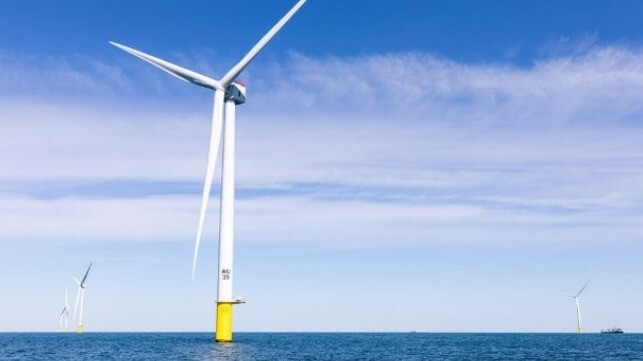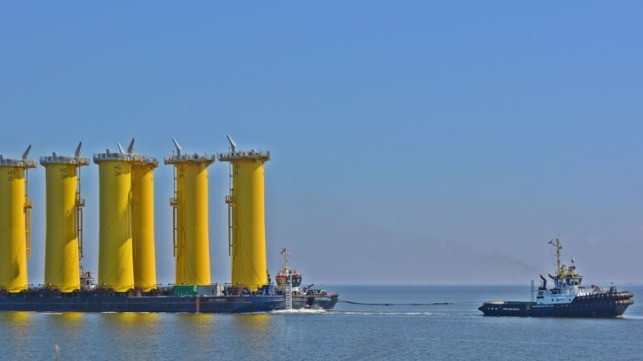Vineyard Wind Reaches Milestone as Largest Operating US Offshore Wind Farm

The Vineyard Wind 1 project passed a key milestone today becoming the largest operating offshore wind farm in the United States. Being developed off the coast of Martha’s Vineyard in Massachusetts, project developers Avangrid and Copenhagen Infrastructure Partners celebrated reaching 136 MW on their way to a total capacity of 806 MW.
With 10 of the planned 62 wind turbines now in operation, Vineyard Wind 1 is now delivering more than 136 MW to the electric grid in Massachusetts. It surpasses Ørsted’s South Fork which was completed earlier this year and has a capacity for 132 MW from 12 turbines. These two projects were the first large-scale offshore wind farms to begin construction in the United States, although they will ultimately be surpassed by others including Dominion Energy’s project off the coast of Virginia which started construction in April 2024.
The companies are highlighting that Vineyard Wind 1 currently has installed 47 foundations and transition pieces and 21 turbines, with the installation of the 22nd turbine underway. Unconfirmed reports in the local media asserted that the project has encountered unanticipated challenges and weather in the installation process slowing its progress.
Located 15 miles off the coast of Martha’s Vineyard, Vineyard Wind began offshore construction in late 2022, achieved steel-in-the-water in June 2023, and completed the nation’s first offshore substation in July 2023. Construction flows through the New Bedford Marine Commerce Terminal.
The project marked its first power delivered to the grid on January 2, when Vineyard Wind delivered approximately five megawatts of power from one turbine to the grid. Following that milestone, the project provided power from each of the first five turbines intermittently, as it ramped up to initial operations, which it achieved in February when the project began delivering approximately 68 MW from five turbines to the grid. At the time, they said that nine turbines had been installed and the process of installing the 10th was underway.
Building on the 136 NW currently being delivered, they report additional power will be delivered to the grid sequentially, with each turbine starting production once it completes the commissioning process.
Vineyard Offshore, the JV operator for the project in March 2024 reported it had submitted a proposal for a 1,200 MW offshore wind project to Massachusetts, Connecticut, and Rhode Island in response to the New England states’ solicitation for up to 6,800 MW of offshore wind capacity. The project, which would be located 29 miles south of Nantucket would be Vineyard Wind 2 with a project operational date of 2031.
The zone south on Martha’s Vineyard and stretching west toward Rhode Island and Connecticut and south to the eastern tip of Long Island is the U.S.’s first cluster for offshore wind. The Bureau of Ocean Energy Management has moved forward with the approvals for additional projects in the zone and ultimately it will host approximately 10 large commercial wind farms.
Germany Proceeds with RWE, TotalEnergies, and EnBW for More Offshore Wind

Germany Proceeds with RWE, TotalEnergies, and EnBW for More Offshore Wind
Germany approved another offshore wind project and awarded two more leases as it moves forward on its next tranche for renewable energy from offshore wind with a focus emerging on large clusters. RWE reports it was given the green light for the first phase of a large project in the North Sea while both TotalEnergies and EnBW won leases for offshore sites in the latest auction.
The Federal Maritime and Hydrographic Agency (BSH) announced the decision as it works to move forward with a broad range of renewable energy projects. With over 8.5 GW installed, Germany has the second-largest offshore wind energy capacity in Europe, nearly double that of the Netherlands. The UK, however, remains the leader in Europe at 14.7 GW of capacity, and second only to China.
BSH President Helge Heegewaldt said they are pleased about the completion of the approval process and the progress they are making. "According to the legally defined targets, a total of 30 GW of installed capacity from offshore wind turbines should be connected to the grid by 2030. At the moment we have an installed capacity of around 8.6 GW. With the current planning approval decisions, we have another building block for achieving the goals of the Offshore Wind Energy Act for an efficient expansion of offshore wind energy."
RWE, which already has six wind farms off the German coast in its portfolio, plans to start construction on the first phase of the Nordseecluster A. BSH approved NC 1 and NC 2 which the company reports will permit to implement the first phase of its 1.6 GW cluster. The company has already taken the investment decision and reports it expects to start offshore construction next year. Production of some components has already started.
The Nordseecluster is being built approximately 30 miles north of the German islands of Borkum and Juist. The first phase, which has now been approved, has a total capacity of 660 MW. The 44 wind turbines of Nordseecluster A, each with a capacity of 15 MW, are expected to be fully connected to the grid in early 2027. The second phase, Nordseecluster B, will add another 900 MW of capacity, with commercial operation expected to begin in early 2029. Together, the wind farms in the Nordseecluster will generate around 6.5 terawatt hours of electricity annually.
BSH also concluded its next auction awarding TotalEnergies’s company Offshore Wind One a concession for a location about 75 miles northwest of the German island of Heligoland. It covers approximately 60 square miles. TotalEnergies says this will permit it to build a 3.5 GW offshore wind hub in the North Sea. The new concession adds 1.6 GW of capacity to the 2 GW area the company won last year. It received a 25-year lease which could be extended to 35 years.
EnBW was awarded a lease for an area also approximately 75 miles from Heligoland. Its plans call for a 1 GW wind farm in the North Sea set to enter operations in 2031. The company already operates four offshore wind farms along the German coast and in May 2024 started construction on He Dreiht, which will be the largest offshore wind farm to be built without state funding. Due to enter operations at the end of 2025, it will add 960 MW to the portfolio which consists of approximately 1 GW from the sites in the North Sea and Baltic. EnBW highlights it has been planning, building, and operating offshore wind farms in Germany and Europe for around 15 years. As a company, it wants to expand renewable energy capacity to between 10 and 11.5 GW by 2030 and be climate-neutral by 2035.
No comments:
Post a Comment